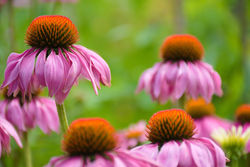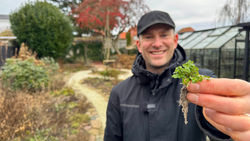Which insects are the best pollinators?
- Lars Wildes
- Jan 24, 2023
- 6 min read
When you plant a pollinator-friendly garden, you’re going to see a whole host of little creatures start showing up.
From the A-listers to the party crashers, here’s a list of who might be coming for dinner and which ones are the superheroes of pollination.
Common garden insects that are great at pollination
Bees

Honey bees, bumblebees, and solitary bees are all important pollinators. These are true rockstars when it comes to moving that pollen. They have specialized mouthparts that allow them to collect nectar and pollen from a wide variety of flowers.
Butterflies and moths

Butterflies flutter from flower to flower, collecting nectar, and spreading pollen as they go. They're not just pretty to look at, they're also hard workers, making sure that plants can reproduce and continue to grow. They're the A-listers of pollination and the ones you want in your garden.
Moths, on the other hand, take the night shift. They fly at night and aren’t as colorful as butterflies. But don’t let that fool you. They're the unsung heroes of the pollination world and just as important as their daytime counterparts.
Beetles

These aren’t the first ones we think of, but any species of beetles, including some ladybugs and fireflies, are important pollinators. They feed on nectar and pollen and transfer pollen as they move around.
Wasps

While not exactly friendly, some species of wasps, such as digger wasps and mud daubers, are actually necessary pollinators. Like the others on this list, they feed on nectar and pollen and then move pollen around as they visit different flowers. Just don’t bother them while they work.
Ants

Ants aren’t the first creatures that come to mind when we think of pollinators, but they do have a sweet tooth for nectar and can help your flowers every now and then. They may not have the fancy wings or the long tongues of bees and butterflies, but they still help out in a small way.
But let's be real, ants are too busy building empires and running the underground, so don’t count on them to pollinate your entire garden.
The best way to attract a variety of these pollinators is to have a wide variety of plants, including native plants, that bloom at different times of the year, providing a continual source of food for these helpful creatures.
Not sure what to plant? Here’s a list of my favorite perennial flowers for your pollinator-friendly garden.
Insects that aren’t so great at pollination
Bless them. Not all insects are great at pollination. Here’s who made this not-so-great list.
Flies

Some species of flies, such as hoverflies, bee flies, and flesh flies, do visit flowers and transfer pollen. But as a whole, ‘flies’ made this list because they’re just not as effective at pollination as bees, butterflies, and other insects that have specialized mouthparts and behaviors for collecting and transferring pollen at a higher level. Sorry, flies.
Mosquitoes

Mosquitoes may visit flowers for a sip of nectar, but they're not exactly known as the ‘good pollinators’ of the insect world.
It’s not their fault. They just don't have the right tools or skills for the job, unlike bees, butterflies, and hummingbirds. Instead of spreading pollen, mosquitoes are more interested in blood-sucking.
So don't count on mosquitoes to help your garden grow. But do count on them to bug you at your next barbeque.
Spiders

Spiders aren't typically considered to be pollinators as they feed on insects and other arthropods, and they do not visit flowers to collect nectar or pollen. They’re also not insects… but I put them on the list because you’ll see them in your garden a lot.
Basically, spiders do not transfer pollen from flower to flower, and they don’t play a significant role in plant reproduction.
Crickets and grasshoppers

Crickets and grasshoppers are not typically considered to be significant pollinators either.
They’re primarily herbivores. That means that they’re in your garden to eat the leaves, stems, and flowers, not help your flowers reproduce.
Sure, they may accidentally transfer small amounts of pollen as they move around, but it’s not their goal. Crickets and grasshoppers have chewing mouthparts not adapted to feed on nectar and pollen and they lack the necessary body parts to transfer pollen from flower to flower.
Plus, crickets and grasshoppers aren’t known to visit multiple flowers in succession — something really important for pollination. And they don’t have a preference for certain colors or scents — another important feature found in insects that pollinate.
What's the best pollinator for a perennial flower garden?
Bees are considered the best pollinators for a garden with perennial flowers.
Honeybees are the most well-known bee pollinators and are often used in commercial farming. My father-in-law lets a local honey farm put up bee hives around his blueberry fields all summer. The bees do their magic and my in-laws get delicious blueberries (and tasty honey).
Honeybees can fly long distances, making them great for large gardens or farms.
Other types of bees like bumblebees, mason bees, and solitary bees are also great pollinators for perennial flowers. They can fly at lower temperatures, meaning they can be active earlier in the spring and later in the fall than honeybees.
They’re also less aggressive and don't tend to sting as often as honeybees.

You Asked — We Answered
Can a fly be a pollinator?
I know we put flies on our not-so-great list. But yes, flies can be pollinators. They’re just not rockstars.
Many species of flies, including hoverflies, bee flies, and flesh flies, visit flowers and transfer pollen from flower to flower. These flies are typically smaller than bees and have shorter tongues. That’s what makes them less effective at collecting nectar from deep flowers. But they can still transfer pollen.
Flies are important for the pollination of plants that bloom early in the season, before bees and other insects are active.
Some are pretty cool. Take hoverflies, for example. They have a similar appearance to bees and wasps, which helps them fool other insects into leaving them alone. They’re known to visit a variety of flowers and can be seen hovering around flowers while they feed on nectar.
Flesh flies have a similar behavior. They’re drawn to flowers with strong odors and love flowers that produce a lot of nectar, like the flowers of the carrot family (Apiaceae) or the Umbellifers like fennel and cow parsley.
But… not all fly species are pollinators. Some aren’t attracted to flowers at all. And others feed on nectar but don’t transfer pollen.
Can ladybugs be pollinators?
Ladybugs (lady beetles or ladybird beetles) aren’t typically considered to be superstar pollinators.
They do visit flowers to feed on nectar and pollen, but their primary diet is aphids, scale insects, and other small insects. Most ladybugs aren’t adapted to feed on nectar and their proboscis (feeding organ) is relatively short, which makes it difficult for them to access nectar in deep flowers. In short, they just don’t transfer pollen as effectively as bees, butterflies, and other insects.
But don’t let their lack of pollination skills turn you off. Ladybugs are super beneficial insects in gardens and agriculture. These cute little bugs are serious predators of many pests.
That’s their primary role in the ecosystem — predator, not pollinator.
I know birds aren’t insects… but are they good pollinators?
Interestingly, birds can be important pollinators for certain plants, although not as common or efficient as insects.
Birds that act as pollinators include hummingbirds, sunbirds, and honeyeaters. They are attracted to brightly colored flowers and feed on nectar. They transfer pollen as they move from flower to flower, with their beaks and heads covered in pollen.
Hummingbirds are specially adapted to be efficient pollinators with long tongues that allow them to reach nectar deep inside tubular flowers. Plus, they can hover in front of the flowers while they feed.
Sunbirds and honeyeaters also have relatively long tongues that help them reach the nectar in deep flowers.
There are some plants adapted to bird pollination. These plants have large, brightly colored flowers that are shaped to make it easy for birds to access the nectar, and they may produce large amounts of nectar to attract birds.
It's worth noting that not all birds are effective pollinators, and some birds, such as sparrows or crows, aren’t attracted to flowers and could care less about nectar. Most birds just eat insects and worms.






Comentários